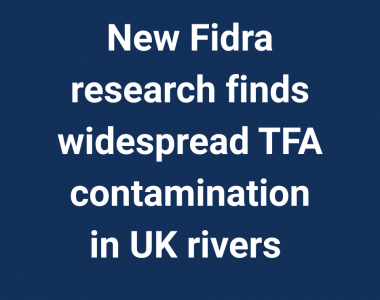TFA – the tiny but prevalent PFAS
Trifluoroacetic acid (TFA) is a short chained PFAS that is a common breakdown product of other larger PFAS used in products such as F-gases, fluoropolymers and pesticides[1]. The scientific community are becoming increasingly concerned about the potentially harmful properties of TFA and increasing levels in the environment, particularly in water sources[2], [3], [4], [5].
TFA belongs to the same PFAS subgroup as PFOA, one of the most toxic and well known PFAS. TFA is the smallest molecule in this group with the shortest perfluorinated carbon chain[3] (Figure 1). Scientists have identified over 2,000 PFAS that can break down into TFA in soils, water, and sediments through biological and light-driven processes[6].
TFA is a persistent substance that can accumulate and linger in the environment[7]. It is also highly mobile, allowing it to spread quickly, especially through the water cycle[5], [6]. Recent studies indicate that TFA is nearly ubiquitous, meaning it has been found extensively across various environmental mediums[1], [8].

How does TFA enter the environment?
Pesticides
PFAS pesticides are thought to be the main source of TFA water contamination in rural areas of Europe[9]. TFA can be formed from the degradation of many PFAS-containing pesticides. Currently, there are estimated to be at least 24 PFAS pesticides approved for use in the UK with the potential to produce TFA. Flufenacet for example, a pesticide commonly associated with TFA, was applied to 2.9 million hectares of UK arable land in 2022—an area nearly twice the size of Wales[10].
Find out more about our work on PFAS pesticides.

Industrial sites
Industrial activities are the main source of TFA contamination in the environment[11], [12]. These include the production of pharmaceuticals, fire-fighting chemicals, fluorinated gases (F-gases) and fluoropolymers. Of these, F-gases are the biggest concern, as they produce gaseous TFA precursors that have significantly boosted TFA levels in the Northern Hemisphere’s atmosphere over the last 30 years[13].

Waste water treatment plants
Wastewater treatment plants (WWTPs) are a significant source of TFA in the environment [4]. Wastewater often contains many TFA precursors, like pharmaceuticals[14], which can form TFA during processing. Standard treatment methods cannot remove TFA[15], so its concentration remains largely unchanged through the treatment cycle. Additionally, WWTPs dealing with high levels of industrial wastewater—such as from pharmaceutical or fluoropolymer production—may see higher TFA concentrations[4].


TFA FAQs
TFA is highly soluble and mobile, which means it’s accumulating in water sources everywhere—from arctic ice[16] and groundwater to rivers, lakes, and even drinking water. Studies sampling surface and groundwater across ten European countries determined over 98% of PFAS found to be TFA [2]. Additionally, TFA has been detected in 94% of tap water samples across 11 European countries and in 63% of bottled mineral and spring waters tested [3]. This pervasive presence of TFA in both natural and drinking water sources is raising concerns about the potential long-term environmental and human health impacts.
TFA is thought to have “low to moderate” toxicity, however, because levels are rapidly rising in the environment, there are concerns about future impacts[17]. Studies have detected TFA in human blood and animal studies suggest potential health risks [18], [19]. For example, TFA exposure has been linked to birth defects in rabbits[20], and similar short chained PFAS have been shown to have toxic effects on freshwater organisms[21].
Recently, Germany proposed classifying TFA as a ‘very Persistent very Mobile’ (vPvM), ‘Persistent Mobile and Toxic’ (PMT), and ‘Reprotoxic’ substance, indicating high environmental and human health concerns, with possible regulatory action ahead in the EU[22], [23], [24].
Given the widespread contamination and potential adverse impacts of TFA, source control is essential. Introducing an overarching restriction on PFAS use in the UK would present a huge opportunity to effectively reduce TFA emissions, as well as wider PFAS pollution, safeguarding both public health and the environment.
It is also important to highlight that many PFAS clean-up technologies generate TFA as a by-product, as they work by breaking down PFAS compounds[11]. This reemphasises the importance of addressing PFAS pollution at source in order to provide any meaningful and long-term solution.
References
[1] H. P. H. Arp, A. Gredelj, J. Glüge, M. Scheringer, and I. T. Cousins, “The Global Threat from the Irreversible Accumulation of Trifluoroacetic Acid (TFA),” Environ Sci Technol, vol. 58, no. 45, pp. 19925–19935, Nov. 2024, doi: 10.1021/acs.est.4c06189.
[2] BUND Friends of the Earth Germany et al., “TFA in Water: Dirty PFAS Legacy Under the Radar,” 2024.
[3] PAN EU et al., “TFA The Forever Chemical in the Water We Drink Only a rapid ban on PFAS pesticides and F-gases can save our water,” 2024.
[4] F. Freeling and M. K. Björnsdotter, “Assessing the environmental occurrence of the anthropogenic contaminant trifluoroacetic acid (TFA),” Jun. 01, 2023, Elsevier B.V. doi: 10.1016/j.cogsc.2023.100807.
[5] M. Scheurer et al., “Small, mobile, persistent: Trifluoroacetate in the water cycle – Overlooked sources, pathways, and consequences for drinking water supply,” Water Res, vol. 126, 2017, doi: 10.1016/j.watres.2017.09.045.
[6] G. Environment Agency, “Reducing the input of chemicals into waters: trifluoroacetate (TFA) as a persistent and mobile substance with many sources.” [Online]. Available: https://www.umweltbundesamt.de/publikationen/
[7] M. de los A. Garavagno, R. Holland, M. A. H. Khan, A. J. Orr-Ewing, and D. E. Shallcross, “Trifluoroacetic Acid: Toxicity, Sources, Sinks and Future Prospects,” 2024. doi: 10.3390/su16062382.
[8] I. T. Cousins, J. H. Johansson, M. E. Salter, B. Sha, and M. Scheringer, “Outside the Safe Operating Space of a New Planetary Boundary for Per- and Polyfluoroalkyl Substances (PFAS),” Environ Sci Technol, vol. 56, no. 16, pp. 11172–11179, Aug. 2022, doi: 10.1021/ACS.EST.2C02765/ASSET/IMAGES/LARGE/ES2C02765_0001.JPEG.
[9] S. Sturm et al., “Trifluoroacetate (TFA): Laying the foundations for effective mitigation – Spatial analysis of the input pathways into the water cycle.”
[10] Fidra, “PFAS active substances in UK pesticides,” 2024. [Online]. Available: www.fidra.org.uk
[11] F. Freeling and M. K. Björnsdotter, “Assessing the environmental occurrence of the anthropogenic contaminant trifluoroacetic acid (TFA),” Jun. 01, 2023, Elsevier B.V. doi: 10.1016/j.cogsc.2023.100807.
[12] H. P. H. Arp, A. Gredelj, J. Glüge, M. Scheringer, and I. T. Cousins, “The Global Threat from the Irreversible Accumulation of Trifluoroacetic Acid (TFA),” Environ Sci Technol, vol. 58, no. 45, pp. 19925–19935, Nov. 2024, doi: 10.1021/acs.est.4c06189.
[13] R. Holland et al., “Investigation of the Production of Trifluoroacetic Acid from Two Halocarbons, HFC-134a and HFO-1234yf and Its Fates Using a Global Three-Dimensional Chemical Transport Model,” ACS Earth Space Chem, vol. 5, no. 4, 2021, doi: 10.1021/acsearthspacechem.0c00355.
[14] M. Inoue, Y. Sumii, and N. Shibata, “Contribution of Organofluorine Compounds to Pharmaceuticals,” ACS Omega, vol. 5, no. 19, pp. 10633–10640, May 2020, doi: 10.1021/acsomega.0c00830.
[15] J. Zhou, N. Saeidi, L. Y. Wick, Y. Xie, F. D. Kopinke, and A. Georgi, “Efficient removal of trifluoroacetic acid from water using surface-modified activated carbon and electro-assisted desorption,” J Hazard Mater, vol. 436, 2022, doi: 10.1016/j.jhazmat.2022.129051.
[16] W. F. Hartz et al., “Levels and distribution profiles of Per- and Polyfluoroalkyl Substances (PFAS) in a high Arctic Svalbard ice core,” Science of the Total Environment, vol. 871, 2023, doi: 10.1016/j.scitotenv.2023.161830.
[17] K. R. Solomon et al., “Sources, fates, toxicity, and risks of trifluoroacetic acid and its salts: Relevance to substances regulated under the Montreal and Kyoto Protocols,” 2016. doi: 10.1080/10937404.2016.1175981.
[18] G. Zheng, S. M. Eick, and A. Salamova, “Elevated Levels of Ultrashort- and Short-Chain Perfluoroalkyl Acids in US Homes and People,” Environ Sci Technol, vol. 57, no. 42, pp. 15782–15793, Oct. 2023, doi: 10.1021/ACS.EST.2C06715/ASSET/IMAGES/LARGE/ES2C06715_0001.JPEG.
[19] Y. Duan, H. Sun, Y. Yao, Y. Meng, and Y. Li, “Distribution of novel and legacy per-/polyfluoroalkyl substances in serum and its associations with two glycemic biomarkers among Chinese adult men and women with normal blood glucose levels,” Environ Int, vol. 134, p. 105295, Jan. 2020, doi: 10.1016/J.ENVINT.2019.105295.
[20] ECHA, “Registration Dossier – ECHA.” Accessed: Jun. 12, 2024. [Online]. Available: https://echa.europa.eu/fr/registration-dossier/-/registered-dossier/5203/7/9/3/?documentUUID=bbe1c0df-91db-4cef-a965-89ded98a88c8
[21] Y. Wang, J. Niu, L. Zhang, and J. Shi, “Toxicity assessment of perfluorinated carboxylic acids (PFCAs) towards the rotifer Brachionus calyciflorus,” Science of the Total Environment, vol. 491–492, 2014, doi: 10.1016/j.scitotenv.2014.02.028.
[22] G. Environment Agency, “Reducing the input of chemicals into waters: trifluoroacetate (TFA) as a persistent and mobile substance with many sources.” [Online]. Available: https://www.umweltbundesamt.de/publikationen/
[23] H. H. Peter Arp et al., “UBA TEXTE 22/2023 A prioritization framework for PMT/vPvM Substances under REACH for registrants, regulators, researchers and the water sector,” 2023.
[24] ECHA, “Registry of CLH intentions until outcome -Trifluoroacetic acid.” Accessed: Jul. 01, 2024. [Online]. Available: https://echa.europa.eu/fr/registry-of-clh-intentions-until-outcome/-/dislist/details/0b0236e188e6e587

